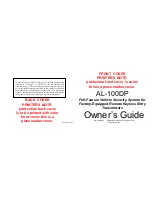
How to distinguish between CO Alarm and Smoke
Alarm warnings
The CO Alarm has a distinctive on-off sound of 3 pulses, fol-
lowed by a pause as compared with a typical Smoke Alarm
which has a rapid pulsing sound.
In addition, when your CO Alarm is sounding the red alarm light
in the centre of the cover will be flashing.
Testing both your CO Alarms and Smoke Alarms weekly will
help you and your family to clearly distinguish between them in
an emergency.
Clean the outside case by occasionally wiping with a clean
damp cloth (disconnect the mains supply at the distribution /
fuse board first). Do
not
use any cleaning agents, bleaches, de-
tergents or polishes,
including
those in aerosol cans. Avoid
spraying air fresheners, hair spray, paint or other aerosols near
the CO Alarm. Do not place air fresheners near the unit.
Use the narrow nozzle of a vacuum cleaner to remove fluff and
other contamination from the cover slots to ensure CO gas can
reach the sensor.
Caution: Do not paint the CO Alarm.
Remove the CO Alarm when decorating. Do not allow water or
dust to contaminate the alarm (see below).
Warning:
Do not open or tamper with the CO Alarm. There are
no user serviceable parts inside. This can damage the unit and
may expose the user to shock or fire hazards.
How to disconnect and remove the alarm:
1. First disconnect the mains supply to the CO Alarm circuit at
the distribution / fuse board.
2. Slide cover up as shown in figure 1.
3. Unscrew the terminal cover screw.
4. Disconnect the wires from the terminal block and make safe,
particularly if the circuit is going to be turned on again after
the CO Alarm is removed.
5. Unscrew from the wall.
(1) The Ei 225E CO Alarm will not work without mains power -
the green power light must be on at all times.
(2) Carbon monoxide must enter the unit for it to be detected.
There may be carbon monoxide in other areas of the house
(e.g. downstairs, in a closed room etc.) but not in the vicinity
of the CO Alarm. Doors, air draughts and obstructions can
prevent the CO reaching the Alarm. For these reasons we
recommend CO Alarms are fitted both near and in bedrooms,
particularly if bedroom doors are closed at night. Additionally
in rooms where members of the household spend much of
their time, and in rooms with potential sources of CO gas.
(3) The CO Alarm may not be heard. The sound output is loud,
but it may not be heard behind a closed door or if it is too far
away. The Alarm may not wake up somebody who has taken
alcohol or drugs. The alarm sound may be masked by other
sounds such as a T.V., stereo, traffic noise etc. Fitting CO
Alarms on either side of closed doors will improve their
chance of being heard. This CO Alarm is not designed for
people with impaired hearing.
(4) CO Alarms don’t last indefinitely. CO Alarms are sophisti-
cated electronic devices with many parts. Although the
alarm and its component parts have undergone stringent
tests, and are designed to be very reliable, it is possible that
parts can fail. Therefore, you should test your CO Alarm
weekly. We recommend that the CO Alarm is replaced after
5 years operation. Check the “replace unit by date” on the
outside of the unit.
(5) CO Alarms are not a substitute for life insurance. House-
holders are responsible for their own insurance. The CO
Alarm warns of increasing CO levels, but we do not guaran-
tee that this will protect everyone from CO poisoning.
(6) CO Alarms are not suitable as early warning Smoke Alarms.
Fire produces carbon monoxide, but the response charac-
teristics of these CO Alarms are such that they would not
give sufficient warning of fire.
Smoke Alarms must be fitted to give early warning of fire.
(7) The CO Alarm does not detect the presence of natural gas
(methane), bottled gas (propane, butane) or other combus-
tible gases. Fit combustion gas alarms to detect these.
(8)
WARNING:
APPARATUS CONFORMING TO THE BS
7860 : 1996 STANDARD MAY NOT PROTECT PEOPLE
WHO ARE AT SPECIAL RISK FROM CARBON MONOX-
IDE EXPOSURE BY REASON OF AGE, PREGNANCY OR
MEDICAL CONDITION. IF IN DOUBT, CONSULT YOUR
MEDICAL PRACTITIONER.
A CARBON MONOXIDE DETECTOR IS NOT A SUBSTI-
TUTE FOR A SMOKE ALARM OR A COMBUSTIBLE GAS
DETECTOR.
Follow these guidelines to reduce the risk of carbon monoxide
poisoning.
(1)
Know and look out for tell-tale signs that carbon monoxide
may be present. These include:
- The CO Alarm warning of abnormal levels.
- Staining, sooting or discolouration on or around appliances.
- A pilot light frequently going out.
- A strange smell when an appliance is working.
- A naked gas flame which is yellow or orange, instead of the
normal blue.
- Family members (including pets) exhibiting the “flu-like”
symptoms of CO poisoning described above.
If any of these signs are present get the appliance checked out
by an expert before further use. If family members are ill get
medical help.
(2)
Choose all appliances and vehicles which burn fossil fuels
such as coal, oil, natural/bottled gas, paraffin, wood, petrol, die-
sel, charcoal etc. with care, and have them professionally in-
stalled and regularly maintained.
(3)
These appliances must “breathe in” air to burn the fuel prop-
erly. Know where the air comes from, and ensure vents/air
bricks etc. remain unobstructed (particularly after building
work).
(4)
The appliances must also “breathe out” the waste gases (in-
cluding the CO) - usually through a flue or chimney. Ensure
chimneys and flues are not blocked or leaking, and get them
checked every year. Check for excessive rust or cracks on ap-
pliances and pipework.
(5)
Never leave your car, motor bike or lawnmower engine run-
ning in the garage with the garage door closed. Never leave the
door from the house to the garage open if the car is running.
(6)
Never adjust your own gas pilot lights.
(7)
Never use a gas cooker or a barbecue for home heating.
(8)
Children should be warned of the dangers of CO poisoning
and instructed never to touch, or interfere with the CO Alarm. Do
not allow small children to press the test/hush button as they
could be subjected to excessive noise when the unit alarms.
(9)
Leaving windows or doors slightly open (even a few inches)
will significantly reduce the risk of high levels of CO occurring.
The high levels of draught-proofing in modern houses reduces
ventilation and allows dangerous gases to build up.
7.
How to Protect your Family
11
12
13
6.
Limitations of CO Alarms
Maintaining Your CO Alarm
5.






















